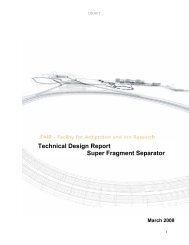FAIR Newsletter No. 12 - GSI Webserver WWW-WIN
FAIR Newsletter No. 12 - GSI Webserver WWW-WIN
FAIR Newsletter No. 12 - GSI Webserver WWW-WIN
You also want an ePaper? Increase the reach of your titles
YUMPU automatically turns print PDFs into web optimized ePapers that Google loves.
<strong>FAIR</strong> <strong>Newsletter</strong> <strong>No</strong>. <strong>12</strong> April 2009<br />
<strong>FAIR</strong> Specials<br />
First PANDA Crystals Have to Withstand their Test Program<br />
Ulrich Wiedner (U Bochum)<br />
Thanks to a grant of the German BMBF, the PANDA collaboration could recently<br />
order 4775 lead-tungstenate (PbWO4) crystals at the firm of BTCP in Russia for the<br />
electromagnetic calorimeter of PANDA (see NL <strong>No</strong> 10, <strong>FAIR</strong> <strong>Newsletter</strong> Archive). In this<br />
connection, very good news came only on December <strong>12</strong>: The Swedish Research<br />
Council decided to finance another 1620 crystals for PANDA. This allows our Russian<br />
supplier to continue their production for <strong>FAIR</strong> until February 2009.<br />
First crystals arrived already end of September at the University of Bochum,<br />
Germany, and by now, a regular schedule of delivery and tests has started.<br />
The quality control is diverse: Prior to their transport to Bochum a first screening of<br />
the crystals is done immediately after production in order to detect instabilities in the<br />
production line already at an early stage and prior to any further actions. Transported<br />
to CERN then, a second step is to run the crystals through the same quality test<br />
procedure that proved already successful for the CMS experiment. The PANDA<br />
collaboration was able to take over the machine from CMS and it was modified<br />
according to the geometry of the PANDA crystals. With a radioactive source, a semiautomatic<br />
ACCOS machine (see pictures) tests the light output and response at different<br />
positions along each individual crystal.<br />
PANDA crystals at CERN in the quality tests with a semiautomated<br />
ACCOS machine<br />
A next step of the quality control will be that of radiation hardness. This will be<br />
done at the University of Giessen, Germany, where a special radiation facility has<br />
been built up only for this purpose. Here, each crystal will be exposed to a very high<br />
radiation dose, simulating the operational demands of several years of PANDA<br />
running. top<br />
14 / 18















